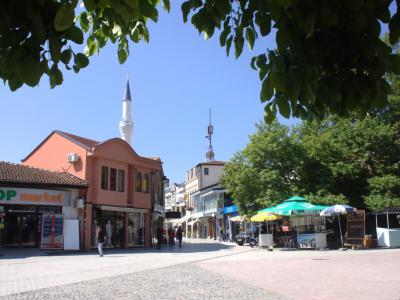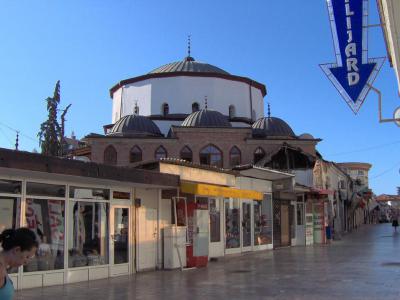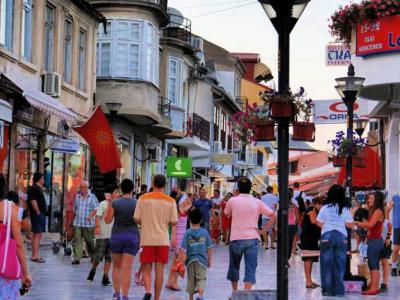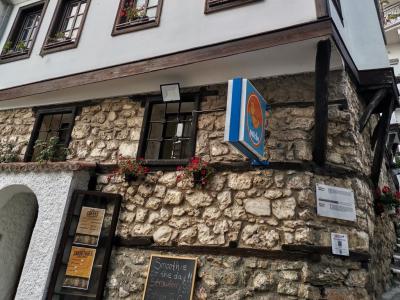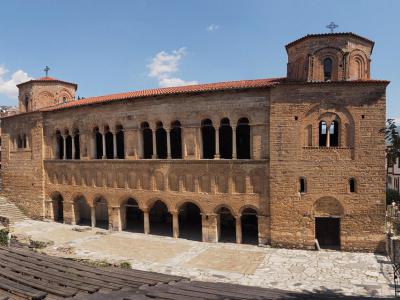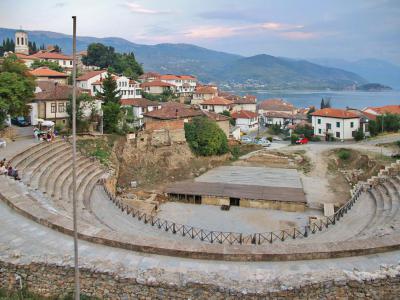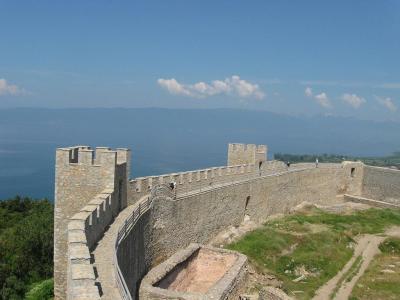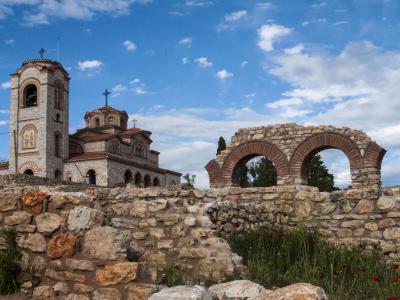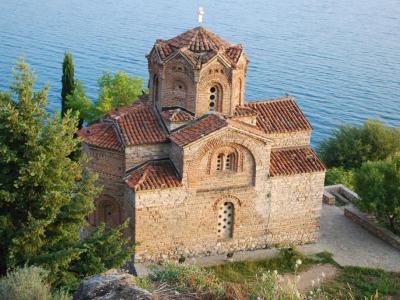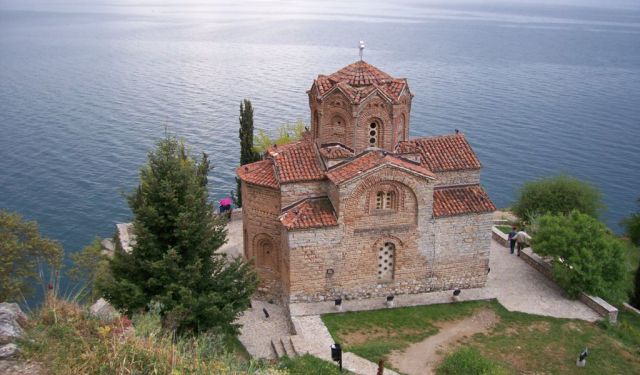
Ohrid Introduction Walking Tour (Self Guided), Ohrid
Ohrid was called "Lychnidos", meaning "City of Light." By the late 9th century, the town was referred to as "Ohrid." This is Slavic, meaning "on a hill." With its 365 churches, it was known as "Jerusalem of the Balkans."
Legend says King Cadmus, banished from Thebes, founded the town on a hill overlooking the lucid waters of Lake Ohrid. That may be, but it was warlike Philip II of Macedon, father of Alexander the Great, who built a fortress on the hill of Ohrid in the 4th century BC. Philip's citadel was rebuilt by King Samoil of Bulgaria in the late 10th century.
The famous Ohrid Literary School was founded in the 9th century by Saint Clement. He was a patron of the Slavic Language and the patron Saint of Ohrid, where he spent his last days. The Ottoman period began in 1395 with the conquest of the city by Bayezid I. Ottoman influence ended in 1912, when the Serbian army took the city in the Balkan Wars.
Ohrid sits sublimely on the edge of the clear blue waters of serene Lake Ohrid. The lake is at least three million years old. The Old Town of Ohrid ascends steep slopes from the lake shore to the heights of Medieval King Samoil's Fortress and its neighbor, Byzantine Saint John of Kaneo Church.
The Old Town is a well preserved cluster of medieval and early modern architecture. The Church of Saint Sophia has Byzantine frescoes. Cafes and restaurants are everywhere to refresh weary hikers.
Plaosnik archeological complex features the multi-domed Church of Saint Panteleimon. The 2,000-year old Greek theatre hosts performances of ballet and operas. Ohrid's tranquil beaches are easily accessible. Shop for unmatchable pearls grown in Ohrid.
In the Main Square above the Old Bazaar, the statue of Saint Clement holds a model of the town. With his right hand he beckons to visitors to come and see the treasures of Ohrid. Accept the invitation and you will be glad you did.
Legend says King Cadmus, banished from Thebes, founded the town on a hill overlooking the lucid waters of Lake Ohrid. That may be, but it was warlike Philip II of Macedon, father of Alexander the Great, who built a fortress on the hill of Ohrid in the 4th century BC. Philip's citadel was rebuilt by King Samoil of Bulgaria in the late 10th century.
The famous Ohrid Literary School was founded in the 9th century by Saint Clement. He was a patron of the Slavic Language and the patron Saint of Ohrid, where he spent his last days. The Ottoman period began in 1395 with the conquest of the city by Bayezid I. Ottoman influence ended in 1912, when the Serbian army took the city in the Balkan Wars.
Ohrid sits sublimely on the edge of the clear blue waters of serene Lake Ohrid. The lake is at least three million years old. The Old Town of Ohrid ascends steep slopes from the lake shore to the heights of Medieval King Samoil's Fortress and its neighbor, Byzantine Saint John of Kaneo Church.
The Old Town is a well preserved cluster of medieval and early modern architecture. The Church of Saint Sophia has Byzantine frescoes. Cafes and restaurants are everywhere to refresh weary hikers.
Plaosnik archeological complex features the multi-domed Church of Saint Panteleimon. The 2,000-year old Greek theatre hosts performances of ballet and operas. Ohrid's tranquil beaches are easily accessible. Shop for unmatchable pearls grown in Ohrid.
In the Main Square above the Old Bazaar, the statue of Saint Clement holds a model of the town. With his right hand he beckons to visitors to come and see the treasures of Ohrid. Accept the invitation and you will be glad you did.
How it works: Download the app "GPSmyCity: Walks in 1K+ Cities" from Apple App Store or Google Play Store to your mobile phone or tablet. The app turns your mobile device into a personal tour guide and its built-in GPS navigation functions guide you from one tour stop to next. The app works offline, so no data plan is needed when traveling abroad.
Ohrid Introduction Walking Tour Map
Guide Name: Ohrid Introduction Walking Tour
Guide Location: Macedonia » Ohrid (See other walking tours in Ohrid)
Guide Type: Self-guided Walking Tour (Sightseeing)
# of Attractions: 10
Tour Duration: 2 Hour(s)
Travel Distance: 2.3 Km or 1.4 Miles
Author: gene
Sight(s) Featured in This Guide:
Guide Location: Macedonia » Ohrid (See other walking tours in Ohrid)
Guide Type: Self-guided Walking Tour (Sightseeing)
# of Attractions: 10
Tour Duration: 2 Hour(s)
Travel Distance: 2.3 Km or 1.4 Miles
Author: gene
Sight(s) Featured in This Guide:
- Ohrid Main Square
- Ali Pasha Mosque
- Old Bazaar Street
- St. Clement Monument
- National Workshop for Handmade Paper
- Church of St. Sophia
- Ancient Theatre of Ohrid
- King Samoil Fortress
- Plaošnik Archaeological Site
- Church of St. John at Kaneo
1) Ohrid Main Square
Ohrid Main Square is known as Krusevska Republika Square. It is not named for Nikita Kruschev, former leader of the Soviet Union. It is named instead in memory of the short-lived uprising against Ottoman rule in the town of Krusevo, Macedonia in 1903. There are several such squares in Macedonia. The Ohrid Main Square is one of them.
The Main Square opens up at the northern end of the Old Bazaar that reaches up from the waterfront. This is the touchstone of Ohrid. There are well tailored flower gardens, and walking spaces paved with marble.
Here is the home of the fabled Chinar tree, said to be 1,000 years old. Minarets and church steeples loom nearby.
The vibes in the square are friendly. Inviting shops and cafes line the edges. There are many comfortable vantage points from which to observe fascinating Ohrid.
The Main Square opens up at the northern end of the Old Bazaar that reaches up from the waterfront. This is the touchstone of Ohrid. There are well tailored flower gardens, and walking spaces paved with marble.
Here is the home of the fabled Chinar tree, said to be 1,000 years old. Minarets and church steeples loom nearby.
The vibes in the square are friendly. Inviting shops and cafes line the edges. There are many comfortable vantage points from which to observe fascinating Ohrid.
2) Ali Pasha Mosque
Within the Old Bazaar of Ohrid the Ali Pasha Mosque lies. It is nearly on the Main Square, close to the 1,000-year old Chinar tree. The fountain in the square sprays and gushes. Many, many years have gone by. The history of the mosque is shorter than that of the tree, but it is long.
The Mosque was built in 1573 by Sulejman Pasha. It was intended as a place of worship and as a secondary school. A reliquary of the bygone rule of the Ottomans, the Mosque is one of the first mosques to be built in Macedonia.
The mosque is constructed of stone and fired brick. There were two minarets. One located on the south side of the mosque was demolished in 1912. The mosque was built with a central dome and an entrance hall covered with three domes. There is a tall minaret on the side. At times, the Square reverberates to the Adzan call to prayer.
Included within the mosque compound are a Turkish bath and a mausoleum. Renovations and restorations have been carried out in recent years by the Turkish Directorate General of Foundations.
The Mosque was built in 1573 by Sulejman Pasha. It was intended as a place of worship and as a secondary school. A reliquary of the bygone rule of the Ottomans, the Mosque is one of the first mosques to be built in Macedonia.
The mosque is constructed of stone and fired brick. There were two minarets. One located on the south side of the mosque was demolished in 1912. The mosque was built with a central dome and an entrance hall covered with three domes. There is a tall minaret on the side. At times, the Square reverberates to the Adzan call to prayer.
Included within the mosque compound are a Turkish bath and a mausoleum. Renovations and restorations have been carried out in recent years by the Turkish Directorate General of Foundations.
3) Old Bazaar Street
The Old Bazaar ain't what it used to be. Or perhaps it never was a world-class market place. Ohrid has always been a religious and cultural center more then anything else. It shines not as a center for trade. So the bazaar is simple. It is just one street extending up from the waterfront to the Main Square of town, not a great distance.
The bazaar extends from the Square downhill to the waterfront or it reaches the square from the shore of Lake Ohrid, whichever way one chooses. It is a walk, no cars. The street is variously paved with cobblestones in the narrow parts or with marble slates in the wider parts. In olden times, the street was covered with grape vines for shade.
Starting from the Main Square, one passes through the food market (formerly an animal market). The few original stores of the bazaar are made of stone. The Ohrid market provides a very different experience than that of Greek or Serbian markets. The open market is not noisy. The merchants sell their foods with a calm not found elsewhere.
After the food market is the Turkish bazaar. Here are kebabs, baklava, Turkish delights, and other foods in the Ottoman legacy. Shoemakers, barbers, leather shops, pearl makers and various other crafts may satisfy the pleasant needs of everyday.
The bazaar extends from the Square downhill to the waterfront or it reaches the square from the shore of Lake Ohrid, whichever way one chooses. It is a walk, no cars. The street is variously paved with cobblestones in the narrow parts or with marble slates in the wider parts. In olden times, the street was covered with grape vines for shade.
Starting from the Main Square, one passes through the food market (formerly an animal market). The few original stores of the bazaar are made of stone. The Ohrid market provides a very different experience than that of Greek or Serbian markets. The open market is not noisy. The merchants sell their foods with a calm not found elsewhere.
After the food market is the Turkish bazaar. Here are kebabs, baklava, Turkish delights, and other foods in the Ottoman legacy. Shoemakers, barbers, leather shops, pearl makers and various other crafts may satisfy the pleasant needs of everyday.
4) St. Clement Monument
The birth place of Saint Clement is not certain. He died in Ohrid, then part of the Bulgarian Empire, in 916. He was a scholar and writer and is credited with the creation of the Cyrillic alphabet. Under Boris I of Bulgaria he established Christian liturgy in Old Slavonic. Sofia University is also named "St Kliment Ohridski."
The monumental statue of Saint Clement in Old Town Square is larger than life. He stands on a marble plinth cradling a model of the city of Ohrid with his left arm. He is studying the model while beckons the observer to come forward and take a look. "Come here, look at this." He seems to be saying.
Saint Clement was the founder of the Ohrid Literary School. He is properly regarded as a patron of Slavic language and education in the area of Ohrid and in Macedonia. He was the first archbishop of the Bulgarian Orthodox Church and one of the Church's Seven Apostles. He is the Patron saint of North Macedonia and the city of Ohrid.
The monumental statue of Saint Clement in Old Town Square is larger than life. He stands on a marble plinth cradling a model of the city of Ohrid with his left arm. He is studying the model while beckons the observer to come forward and take a look. "Come here, look at this." He seems to be saying.
Saint Clement was the founder of the Ohrid Literary School. He is properly regarded as a patron of Slavic language and education in the area of Ohrid and in Macedonia. He was the first archbishop of the Bulgarian Orthodox Church and one of the Church's Seven Apostles. He is the Patron saint of North Macedonia and the city of Ohrid.
5) National Workshop for Handmade Paper
Master Guttenberg would have loved Ohrid's National Workshop for Handmade Paper. Not only do they have an exact replica of the Master's printing press, they make their own paper in the old way. They create the pulp to be used and press and dry it. Nothing electronic, not a place for computer nerds. Here, everything is crafted by hand.
The replica 15th century press is one of the only two known to exist in the world. The Workshop staff print copies of historical documents, books and etchings and drawings. They readily demonstrate paper making and printing by hand.
The art of paper making (non-papyrus), is said to have originated in China in the 2nd century BC. Paper making began in Macedonia in the latter half of the 16th century in the Monastery of St. Naum. The National Workshop continues the time-honored methods of paper making. In their small museum they sell handmade paper gift products.
The replica 15th century press is one of the only two known to exist in the world. The Workshop staff print copies of historical documents, books and etchings and drawings. They readily demonstrate paper making and printing by hand.
The art of paper making (non-papyrus), is said to have originated in China in the 2nd century BC. Paper making began in Macedonia in the latter half of the 16th century in the Monastery of St. Naum. The National Workshop continues the time-honored methods of paper making. In their small museum they sell handmade paper gift products.
6) Church of St. Sophia (must see)
The Cathedral of St Sophia was built in Ohrid in the 9th century by Boris II. It was rebuilt in the 11th century and provided with a domed basilica by Archbishop Leo of Ohrid. A Great Feast mural adorns the nave.
In the recess of the apse the Virgin Enthroned holds her son in a protective mandorla. Christ prepares bread and wine below. On the walls behind the altar platform (the "bema") is a sequence of scenes from the lives of Abraham, St Basil the Great and St John Chrysostum. Above the alcove where sacerdotales are kept are scenes of martyrdoms.
The church was dedicated to Holy Wisdom ("Hagia Sofia"). It was built on the foundation of an early Christian basilica of the 5th century. In the 15th century the church was converted to a mosque. The precious frescoes were white-washed. During their regime, the Ottomans caused a lot of damage to the church.
After the Balkan Wars of 1912, St Sophia was returned to her role as an Orthodox Church and a conservation project was initiated. The frescoes were cleaned and rejuvenated and the church once again expressed the Byzantine world of the 11th century.
Every year the one-month Ohrid Summer Festival is opened by an operatic concert at Saint Sophia's. The first concert was in August, 1961. Inside the church, Macedonian opera star Ana Lipsha Tofovic and pianist Ladislav Peridic gave a bravura performance. It was a first for Ohrid and a first for the church.
In the recess of the apse the Virgin Enthroned holds her son in a protective mandorla. Christ prepares bread and wine below. On the walls behind the altar platform (the "bema") is a sequence of scenes from the lives of Abraham, St Basil the Great and St John Chrysostum. Above the alcove where sacerdotales are kept are scenes of martyrdoms.
The church was dedicated to Holy Wisdom ("Hagia Sofia"). It was built on the foundation of an early Christian basilica of the 5th century. In the 15th century the church was converted to a mosque. The precious frescoes were white-washed. During their regime, the Ottomans caused a lot of damage to the church.
After the Balkan Wars of 1912, St Sophia was returned to her role as an Orthodox Church and a conservation project was initiated. The frescoes were cleaned and rejuvenated and the church once again expressed the Byzantine world of the 11th century.
Every year the one-month Ohrid Summer Festival is opened by an operatic concert at Saint Sophia's. The first concert was in August, 1961. Inside the church, Macedonian opera star Ana Lipsha Tofovic and pianist Ladislav Peridic gave a bravura performance. It was a first for Ohrid and a first for the church.
7) Ancient Theatre of Ohrid (must see)
A novel recipe for the preservation of ancient theatres in good condition is to bury them! In the early 20th century, Russian art historian Nikodim P. Kondakov theorized that a Hellenistic theater once existed in ancient Lychnidos (Ohrid today). In 1935 archeological excavations indeed revealed bits of what could be a theatre in Ohrid.
By 1984 the the theatre entrances, the building itself, the orchestra, honorary seats, the arena and nine rows of the audience were exposed. By 2000 the theatre was fully exposed and useable. It was a theatre, Greek, not Roman, in near perfect condition. Built perhaps in the 3rd century BC, it had been buried deliberately. But why?
During the Roman era the theatre was used for gladiatorial fights and much to the disgust of the locals, the public killing of Christians. Because of this dislike, the theatre was abandoned and buried. This caused the theatre to be near perfectly preserved. The theatre had returned but without the gladiators and the lions.
From the 1980s onward the theatre has become a venue for plays, concerts, operas and ballet. There have been appearances of groups and artists such as the famed Bolshoi Ballet and Jose Carreras. The theatre is one of the main stages for the annual Ohrid Summer Festival. It is situated on the slope of the highest hill under the Samoil Fortress.
By 1984 the the theatre entrances, the building itself, the orchestra, honorary seats, the arena and nine rows of the audience were exposed. By 2000 the theatre was fully exposed and useable. It was a theatre, Greek, not Roman, in near perfect condition. Built perhaps in the 3rd century BC, it had been buried deliberately. But why?
During the Roman era the theatre was used for gladiatorial fights and much to the disgust of the locals, the public killing of Christians. Because of this dislike, the theatre was abandoned and buried. This caused the theatre to be near perfectly preserved. The theatre had returned but without the gladiators and the lions.
From the 1980s onward the theatre has become a venue for plays, concerts, operas and ballet. There have been appearances of groups and artists such as the famed Bolshoi Ballet and Jose Carreras. The theatre is one of the main stages for the annual Ohrid Summer Festival. It is situated on the slope of the highest hill under the Samoil Fortress.
Sight description based on Wikipedia.
8) King Samoil Fortress (must see)
Ohrid fortress, popularly known as Tsar Samoil Fortress, is a restored medieval stronghold that occupies the top of Ohrid hill. The hill rises 328 feet above the waters of Lake Ohrid, giving the fort a commanding view over the lake, the city and surrounding countryside. The ramparts extend for two miles, varying in height from ten to 53 feet.
The fortress was built upon the ruins of an earlier fort built in the 4th century BC by none other than Philip II, King of Macedonia and father of Alexander the Great. King Samoil built his medieval style fortress on the remains of Philip's creation in the late 10th century AD.
Ohrid, known in ancient times as "Lychnidos", has been ruled by Romans, Byzantines, Slavs and Ottomans. They destroyed and rebuilt the fortress in turn several times. The fortress has served as a defensive asset and also as a residence. The citadel center is divided by a wall into two parts. The Emperor lived in one and soldiers in the other.
The wall surrounding this space has a row of towers. The main entrance is flanked by two semicircular keep-like defensive towers. The remaining part of the fort is wrapped by a defensive wall around a residential area for courtiers' families. In this second area is an ancient cemetery, the ruins of a donjon and a cistern.
Until the arrival of the Ottomans in 1395, the city was completely enclosed within the walls. Only the Upper and Lower Gates provided access to the town. After the Turkish involvement the town expanded beyond the walls. Christians were kept in the walled up hill section. The Ottoman quarter was outside on lower, more open ground.
In the year 2000 conservation and restoration efforts were started on the fort. The walls and towers of the citadel were repaired and preserved. From the archeological complex of Plaosnik there is a wooded path to the citadel. Admission is free.
The fortress was built upon the ruins of an earlier fort built in the 4th century BC by none other than Philip II, King of Macedonia and father of Alexander the Great. King Samoil built his medieval style fortress on the remains of Philip's creation in the late 10th century AD.
Ohrid, known in ancient times as "Lychnidos", has been ruled by Romans, Byzantines, Slavs and Ottomans. They destroyed and rebuilt the fortress in turn several times. The fortress has served as a defensive asset and also as a residence. The citadel center is divided by a wall into two parts. The Emperor lived in one and soldiers in the other.
The wall surrounding this space has a row of towers. The main entrance is flanked by two semicircular keep-like defensive towers. The remaining part of the fort is wrapped by a defensive wall around a residential area for courtiers' families. In this second area is an ancient cemetery, the ruins of a donjon and a cistern.
Until the arrival of the Ottomans in 1395, the city was completely enclosed within the walls. Only the Upper and Lower Gates provided access to the town. After the Turkish involvement the town expanded beyond the walls. Christians were kept in the walled up hill section. The Ottoman quarter was outside on lower, more open ground.
In the year 2000 conservation and restoration efforts were started on the fort. The walls and towers of the citadel were repaired and preserved. From the archeological complex of Plaosnik there is a wooded path to the citadel. Admission is free.
9) Plaošnik Archaeological Site (must see)
Barely 825 feet downhill from Samoil's Fortress on Ohrid hill is the Plaosnik Archeological Site, an ongoing excavation and research site of early Lychnidos, aka Ohrid. The main find on the site is the church built by Saint Clement in 893. The church was built on the foundation of an earlier Christian basilica.
The early basilica was dedicated to the legendary 4th century martyr, Saint Panteleimon, whose name means "All-merciful." The Ohrid Literary School was founded on this site by Saint Clement in the 9th century. The school became the leading center of Slavic culture. Saint Clement was buried in this church in a tomb built by himself.
Under Ottoman rule, Saint Clement's was converted into a mosque called the Imaret Mosque. The mosque was a memorial by Sinan Chelebi of the prestigious Turkish family of Ohrizade. The remains of the mosque were relocated in 2000. It had been covering the earlier Christian church and basilica.
Discoveries as of 2007 include the baptistery of the five aisled basilica. There are mosaic tiled mosaic floors dated from the 4th to 6th centuries. The mosaics show forms of fanciful animals, curvilinear geometrics, and swastikas as symbols of a nourishing sun. In 2007, 2,383 Venetian coins were discovered, linking Venice and Ohrid in trade.
The early basilica was dedicated to the legendary 4th century martyr, Saint Panteleimon, whose name means "All-merciful." The Ohrid Literary School was founded on this site by Saint Clement in the 9th century. The school became the leading center of Slavic culture. Saint Clement was buried in this church in a tomb built by himself.
Under Ottoman rule, Saint Clement's was converted into a mosque called the Imaret Mosque. The mosque was a memorial by Sinan Chelebi of the prestigious Turkish family of Ohrizade. The remains of the mosque were relocated in 2000. It had been covering the earlier Christian church and basilica.
Discoveries as of 2007 include the baptistery of the five aisled basilica. There are mosaic tiled mosaic floors dated from the 4th to 6th centuries. The mosaics show forms of fanciful animals, curvilinear geometrics, and swastikas as symbols of a nourishing sun. In 2007, 2,383 Venetian coins were discovered, linking Venice and Ohrid in trade.
10) Church of St. John at Kaneo (must see)
The Church of Saint John the Theologian sits on a cliff overlooking Kaneo Beach and Lake Ohrid. It is really next door to the Plaosnik Archeological Site and St Clement's Church. The John referred to is John of Patmos, credited to be the writer of Revelations. According to some historians, he may also have been John the Apostle.
It is not known precisely when the church was built. Certain documents indicate construction was perhaps in the 13th century, well before the rise of the Ottoman Empire which eventually engulfed Macedonia.
The church is laid out in a cruciform plan on a rectangular base. Unfortunately, the architect is not yet known. The church has a single dome. The roof cornice is unusual. It is neither flat nor undulating in the normal manner. It forms angled tympanums between a doorway lintel and the arch above. This is customary in the central Balkans.
Frescoes dating from the 1200s are intact in the dome apse. The naos niche contains bits from the Passion of Christ. The altar space holds scenes of the liturgy and the Worship of the Lamb. There are portraits of Saints Clement of Ohrid, Erasmus of Lychnidos and Constantine Cabasilas, Ohrid Archbishop in the 1260s.
Christ Pancrator is featured in a fresco in the church dome. The Church of Saint John is a pleasant walk from the fortress of Tsar Samoil downhill through the pine forest. The views of Lake Ohrid and the old town are sweeping and dramatic. For weary, hungry hikers there is no dearth of friendly restaurants at the water's edge.
It is not known precisely when the church was built. Certain documents indicate construction was perhaps in the 13th century, well before the rise of the Ottoman Empire which eventually engulfed Macedonia.
The church is laid out in a cruciform plan on a rectangular base. Unfortunately, the architect is not yet known. The church has a single dome. The roof cornice is unusual. It is neither flat nor undulating in the normal manner. It forms angled tympanums between a doorway lintel and the arch above. This is customary in the central Balkans.
Frescoes dating from the 1200s are intact in the dome apse. The naos niche contains bits from the Passion of Christ. The altar space holds scenes of the liturgy and the Worship of the Lamb. There are portraits of Saints Clement of Ohrid, Erasmus of Lychnidos and Constantine Cabasilas, Ohrid Archbishop in the 1260s.
Christ Pancrator is featured in a fresco in the church dome. The Church of Saint John is a pleasant walk from the fortress of Tsar Samoil downhill through the pine forest. The views of Lake Ohrid and the old town are sweeping and dramatic. For weary, hungry hikers there is no dearth of friendly restaurants at the water's edge.
Walking Tours in Ohrid, Macedonia
Create Your Own Walk in Ohrid
Creating your own self-guided walk in Ohrid is easy and fun. Choose the city attractions that you want to see and a walk route map will be created just for you. You can even set your hotel as the start point of the walk.
Ohrid's Historical Churches
According to the legend based on the observations of 15th-century Ottoman traveler Evlia Celebia, the town of Ohrid used to have within its boundaries 365 chapels – one for every day of the year. At some point during Medieval times, Ohrid was even dubbed Slavic Jerusalem. Today, although the number of churches is considerably smaller, the architectural and historical value of those that remain... view more
Tour Duration: 1 Hour(s)
Travel Distance: 2.7 Km or 1.7 Miles
Tour Duration: 1 Hour(s)
Travel Distance: 2.7 Km or 1.7 Miles
The Most Popular Cities
/ view all
